Industrialization of Agriculture
Background
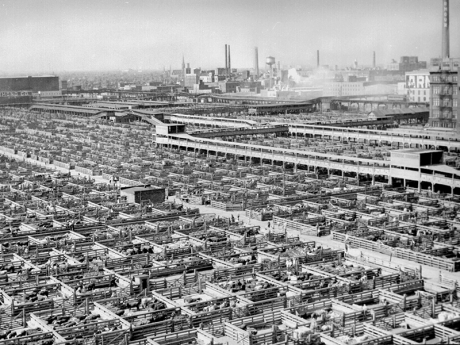
The meatpacking plant of Chicago’s Union Stockyards was a sprawling facility that handled the slaughter, processing, packaging, and distribution of cattle and swine. In operation by 1865, it was among the earliest U.S. businesses to exemplify the industrial model, setting precedents other industries would follow. Henry Ford even credited the animal “disassembly” lines at Union Stockyards with inspiring the idea for his automobile manufacturing plants.3
Photo credit: John Vachon, 1941. Public domain.
In the early 1900s, more than half of Americans were either farmers or lived in rural communities.1 Most U.S. farms were diversified, meaning they produced a variety of crops and animal species together on the same farm, in complementary ways.2 Farmers were skilled in a wide range of trades and had autonomy over how to manage their crops and animals. Animals were typically raised with access to the outdoors. Most of the work on the farm was done by human or animal labor.
Although conditions like these still exist, the industrialization of agriculture radically transformed how the vast majority of food is produced in the U.S. and many other parts of the world. Over the brief span of the 20th century, agriculture underwent greater change than it had since it was first adopted some 13,000 years ago. Modern U.S. agriculture has been described as “the most efficient in the world, at least in terms of the dollar and cent costs of production.”1 The public health and ecological costs of industrialization, however, are not reflected in the prices of food.
Specialization
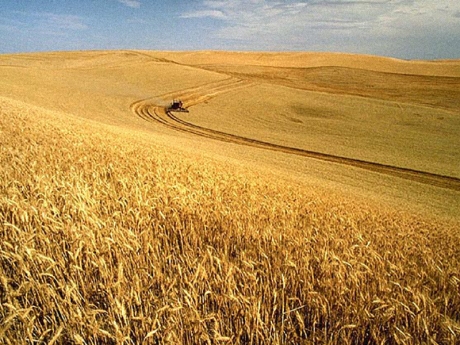
Wheat harvest in Idaho.
Specialization aims to increase efficiency by narrowing the range of tasks and roles involved in production. This approach was applied to nearly all facets of food production. Diversified farms gave way to genetically uniform monocultures—fields planted with just one crop species at a time, over a very large area.
Photo credit: USDA. Public domain.
Specialization aims to increase efficiency by narrowing the range of tasks and roles involved in production. A diversified farmer, for example, might need to manage and care for many different vegetable crops, a composting operation, a flock of egg-laying hens, a sow, and her litter of piglets. Specialized farmers, by contrast, can focus all their knowledge, skills, and equipment on one or two enterprises, such as growing corn and soy, or fattening beef cattle. Over the course of industrialization, specialization was applied to nearly all facets of food production.
Diversified farms gave way to genetically uniform monocultures—fields planted with just one crop species at a time, such as corn, wheat, or soy, over a very large area. Meat, milk, and egg production became largely separated from crop production and involved facilities that housed a single breed of animal, during a particular period of its lifespan, for a single purpose (e.g., breeding, feeding, or slaughter). Farmers, once skilled in a breadth of trades, fell into more specialized roles.
Specialization was also applied to animal genetics, as selective breeding produced animals designed for a single outcome—large breast meat, for example, or increased milk production. Compared to chickens of the 1930s, today’s chickens bred for meat (“broilers”) grow to almost twice the weight, in less than half the time, using less than half as much feed.4 Genetic selection for these exaggerated traits has often come at the expense of the animals’ health, including increased risks for heart failure in broilers and udder infections in dairy cows bred for higher milk production.5
Mechanization
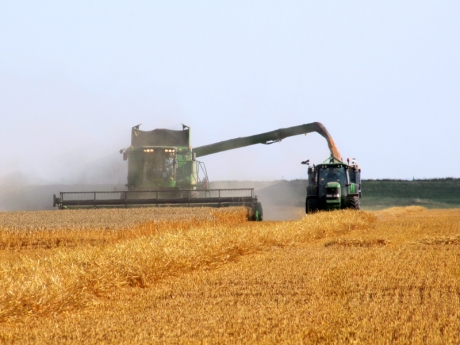
The combine harvester performs two processes at once: cutting grain (reaping) and removing it from the inedible part (threshing).
Mechanization in agriculture greatly reduced the need for human and animal labor. From 1950 to 2000, production on U.S. farms more than doubled with less than a third of the labor costs.8
Photo credit: Dan Davidson, 2010. Creative Commons CC BY 2.0.
Like work on an assembly line, specialized labor often involves repetitive tasks that can be performed by machines. This meant routine jobs like sowing seeds, harvesting crops, milking cows, and feeding and slaughtering animals could be mechanized, reducing (and in some cases eliminating) the need for human and animal labor. Between 1900 and 2000, the share of the U.S. workforce involved in agriculture declined from 41 percent to 2 percent.6
In some cases, mechanization brought tremendous gains in efficiency. Grain and bean crops, such as corn, wheat, rice, and soy, must be cut from the fields (reaped) and removed from the inedible parts of the plant (threshed). Doing this by hand involves an enormous amount of time and effort. By hand, a person can thresh roughly 15 to 40 kg of grain per hour, usually by beating the harvested crop against a hard surface to shake the grain loose from the inedible chaff that surrounds it. In the same amount of time, a mechanized thresher can process 450 to 600 kg of rice, sorghum, or beans, or 1,500 to 2,000 kg of corn.7
Chemical and Pharmaceutical Inputs
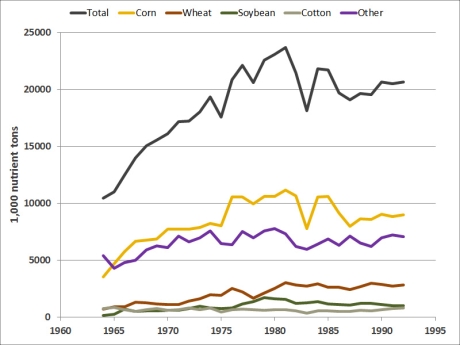
Fertilizer applications on U.S. crops, 1964–92.
Synthetic nitrogen fertilizers, introduced in the early 1900s, have been credited with feeding the lion’s share of a global population that grew from 1.6 to 6 billion over the 20th century. In just 12 years, between 1964 and 1976, synthetic and mineral fertilizer applications on U.S. crops nearly doubled.9
The early 1900s saw the introduction of synthetic fertilizers and chemical pesticides, innovations that have become a hallmark of industrial crop production. In just 12 years, between 1964 and 1976, synthetic and mineral fertilizer applications on U.S. crops nearly doubled, while pesticide use on major U.S. crops increased by 143 percent.9 The shift to specialized monocultures increased farmers’ reliance on these chemicals, in part because crop diversity can help suppress weeds and other pests.10,11
Chemical and pharmaceutical use also became commonplace in newly industrialized models of meat, milk, and egg production. Antibiotics, for example, were introduced to swine, poultry, and cattle feed after a series of experiments in the 1940s and 1950s found that feeding the drugs to animals caused them to gain weight faster and on less feed.12 By 2009, 80 percent of the antibiotic drugs sold in the U.S. were used not for human medicine but for livestock production.13
As with other trends in industrialization, the use of chemical and pharmaceutical inputs in agriculture offered gains in productivity, but not without health and ecological consequences.
Consolidation
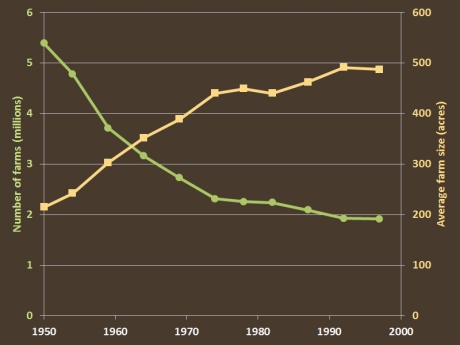
Consolidation in U.S. farms, 1950–1997.
Consolidation in agriculture is the shift toward fewer and larger farms. The total number of U.S. farms declined from 5.39 million to 1.91 million between 1950 and 1997. Over the same period, the average size of U.S. farms more than doubled (from 215 to 487 acres).16
Consolidation in agriculture is the shift toward fewer and larger farms, usually as a result of large farms getting larger and smaller farms going out of business. In the late 1950s, U.S. Secretary of Agriculture Ezra Taft Benson exemplified government pressure to consolidate when he called on farmers to “get big or get out.”14
Between 1950 and 1997, the average U.S. farm more than doubled in size, and less than half the farms remained.15 In meat, dairy, and egg production, the number of animals on each farm rose dramatically, while the number of small farms declined. Many other industries in the food system, including animal slaughtering and processing, also underwent major consolidation.
What drove the push to consolidate? New technology, including chemicals and larger tractors, allowed farmers to work larger areas of land with less labor.2 Government policies encouraged farmers to scale up their operations. Farmers were also motivated by economies of scale—the economic advantage of producing larger numbers of products. A chicken farmer, for example, might turn a greater profit on each bird by housing a larger number of birds (up to a point).
Largely as a result of consolidation, most food production in the U.S. now takes place on massive-scale operations. Half of all U.S. cropland is on farms with at least 1,000 acres (over 1.5 square miles).2 The vast majority of U.S. poultry and pork products comes from facilities that each produce over 200,000 chickens or 5,000 pigs in a single year, while most egg-laying hens are confined in facilities that house over 100,000 birds at a time.16
Market Concentration
Decisions about who produces our food, what food is produced, how it is produced, and who gets to eat that food have been steadily moving from … households and governments to … corporation boardrooms.
– Mary Hendrickson and Harvey S. James Jr.19
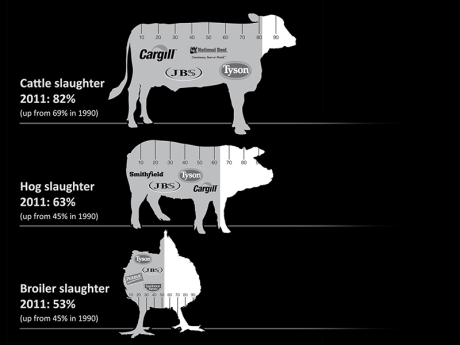
Percentage of sales earned by the four largest companies in their respective industries.20,23
Earnings from food and agricultural industries have become increasingly concentrated among a small number of powerful companies. In the U.S. beef slaughtering and processing industry, the four largest companies earn 82 percent of the sales.
Image credit: Michael Milli and Brent Kim. Johns Hopkins Center for a Livable Future, 2013.
Market share is the proportion of an industry’s sales earned by one company. In the U.S. market for salty snacks, for example, 64 percent of sales are earned by PepsiCo.18
When a small number of companies have a large market share of an industry, the market for that industry is said to be concentrated. Markets become more concentrated when companies take over, or merge with, their competitors.
Over the course of industrialization, markets for food and agricultural products have become increasingly concentrated. In the U.S. beef slaughtering and processing industry, for example, the four largest companies earn 82 percent of the sales.19 In the supermarket industry, four companies earn at least 42 percent of the sales.20
Vertical integration is a type of market concentration that occurs when companies gain control of multiple industries involved in the same products. Smithfield Foods, for example, is involved in the breeding, production, slaughter, processing, and marketing of hogs and pork products.21 A small number of powerful corporations have similar control over poultry industries.
What does market concentration mean for farmers and consumers? In some cases, market concentration can lower prices for consumers and increase sales.22 On the other hand, with fewer competitors in a concentrated market, dominant companies may gain greater power to influence prices in their favor.22 They may also dictate how foods are produced, leaving farmers with little choice over how to grow crops or raise animals.17 Many highly concentrated corporations also have a strong presence in government agencies, where they can influence policies in their favor.23
Resources
This list is a starting point for further exploration. Some materials may not reflect the views of the Johns Hopkins Center for a Livable Future.
For teachers
- Industrialization of Agriculture (lesson plan). FoodSpan. Johns Hopkins Center for a Livable Future.
- Introduction to the US Food System: Public Health, Environment, and Equity (textbook). Neff RN (editor). Johns Hopkins Center for a Livable Future. 2014.
Reports
- Putting Meat on the Table: Industrial Farm Animal Production in America. Pew Commission on Industrial Farm Animal Production. 2008.
- Concentration of Agricultural Markets. Hendrickson M, Heffernan W. 2007.
Academic journal articles
- The Ethics of Constrained Choice: How the Industrialization of Agriculture Impacts Farming and Farmer Behavior. Hendrickson M, James HS. Journal of Agricultural and Environmental Ethics. 2005.
- How Sustainable Agriculture Can Address the Environmental and Human Health Harms of Industrial Agriculture (open access). Horrigan L, Lawrence RS, Walker P. Environmental Health Perspectives. 2002.
Books
- Foodopoly: The Battle Over the Future of Food and Farming in America. Wenonah Hauter. 2012.
- Crisis and Opportunity: Sustainability in American Agriculture. John E. Ikerd. 2008.
- Chicken: The Dangerous Transformation of America's Favorite Food. Steve Striffler. 2005.
References
- Ikerd JE. Sustaining the profitability of agriculture. In: Economist’s Role in the Agricultural Sustainability Paradigm. San Antonio, TX: University of Missouri; 1996.
- MacDonald J, Korb P, Hoppe R. Farm Size and the Organization of U.S. Crop Farming. 2013.
- Rifkin J. Beyond Beef: The Rise and Fall of the Cattle Culture. New York, New York: Plume; 1993.
- Striffler S. Chicken: The Dangerous Transformation of America`s Favorite Food. New Haven: Yale University Press; 2005.
- Rauw WM, Kanis E, Noordhuizen-Stassen E., Grommers F. Undesirable side effects of selection for high production efficiency in farm animals: a review. Livest Prod Sci. 1998;56(1):15-33.
- Dimitri C, Effland A, Conklin N. The 20th Century Transformation of U.S. Agriculture and Farm Policy. USDA ERS. 2006.
- M. de Lucia, Assennato D. Agricultural Engineering in Development: Post-Harvest Operations and Management of Foodgrains. Food and Agriculture Organization of the United Nations; 1994.
- USDA Economic Research Service. Agricultural Productivity in the United States. 2014.
- Lin B-H, Padgitt M, Bull L, Delvo H, Shank D, Taylor H. Pesticide and Fertilizer Use and Trends in U.S. Agriculture. 1995.
- Liebman M, Davis AS. Integration of soil, crop and weed management in low-external-input farming systems. Weed Res. 2000;40:27-47.
- Kirschenmann FL. Potential for a new generation of biodiversity in agroecosystems of the future. Agron J. 2007;99(2):373-376.
- Gustafson RH, Bowen RE. Antibiotic use in animal agriculture. J Appl Microbiol. 1997;83(5):531-41.
- U.S. Food and Drug Administration. Letter to The Honorable Louise M. Slaughter: Sales of Antibacterial Drugs in Kilograms. Washington D.C.; 2010.
- Zimdahl RR. Agriculture’s Ethical Horizon. 2nd ed. Waltham, MA: Elsevier; 2012.
- Hoppe RA, Banker DE. Structure and Finances of U.S. Farms: 2005 Family Farm Report. Vol Economic I. USDA Economic Research Service; 2006.
- USDA. 2012 U.S. Census of Agriculture. 2014.
- Hendrickson MK, James HS. The Ethics of Constrained Choice: How the Industrialization of Agriculture Impacts Farming and Farmer Behavior. J Agric Environ Ethics. 2005;18(3):269-291.
- Cooper T. This Company Seeks to Dominate Snacks. The Motley Fool. 2013.
- James HS, Hendrickson MK, Howard PH. Networks, Power, and Dependency in the Agrifood Industry. In: James HS, ed. The Ethics and Economics of Agrifood Competition. Dordrecht: Springer Science-Business Media Press; 2013:99-126.
- Hendrickson M, Heffernan W. Concentration of Agricultural Markets. 2007.
- Martinez SW. Vertical Coordination in the Pork and Broiler Industries: Implications for Pork and Chicken Products. 1999.
- Shields DA. Consolidation and Concentration in the U.S. Dairy Industry. 2010.
- Heffernan WD, Douglas HC. Concentration of Agricultural Markets. 1990.
